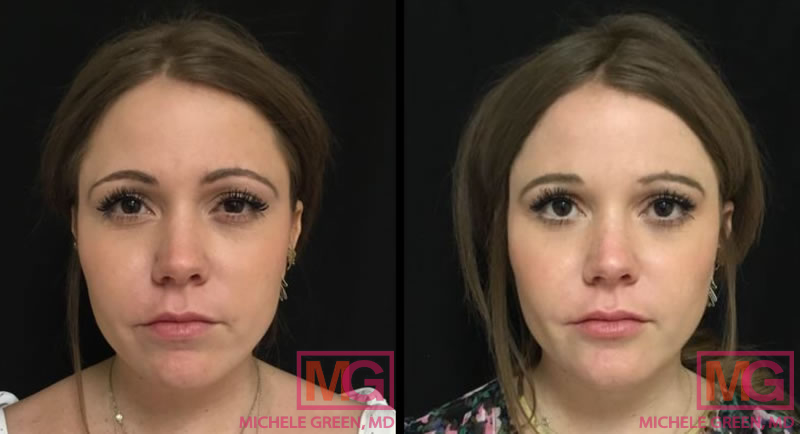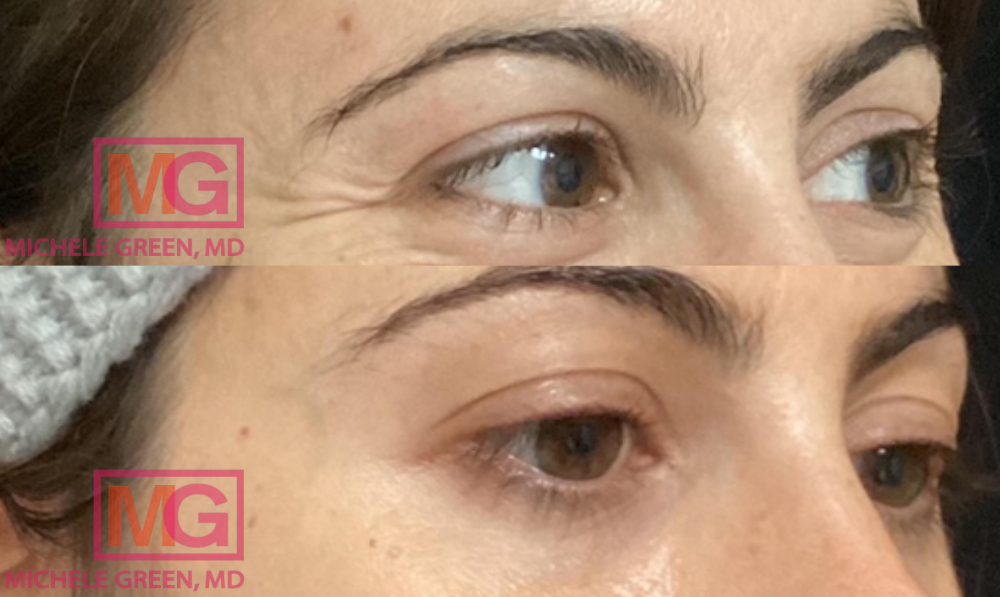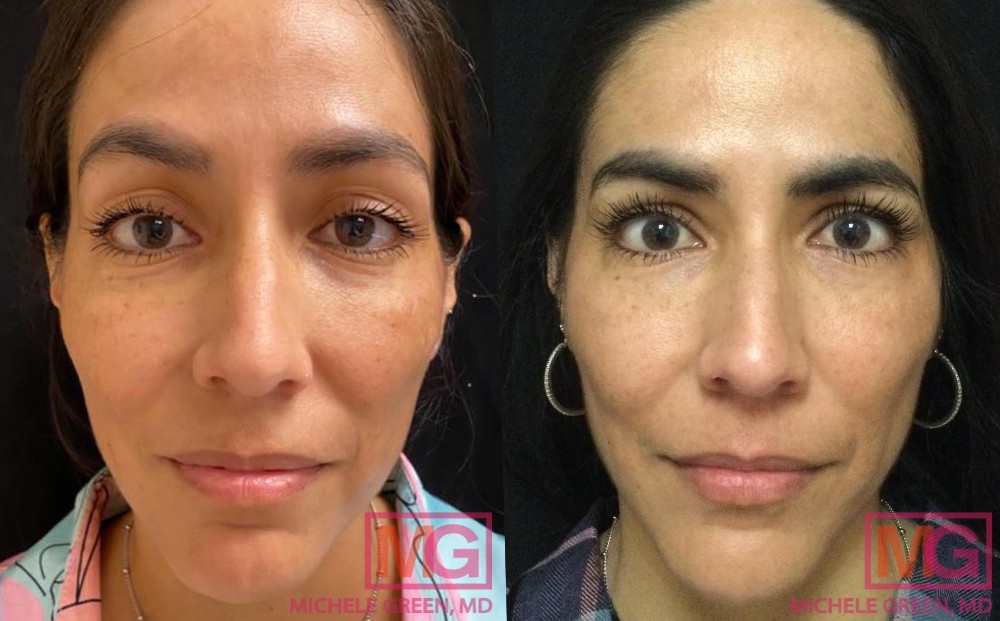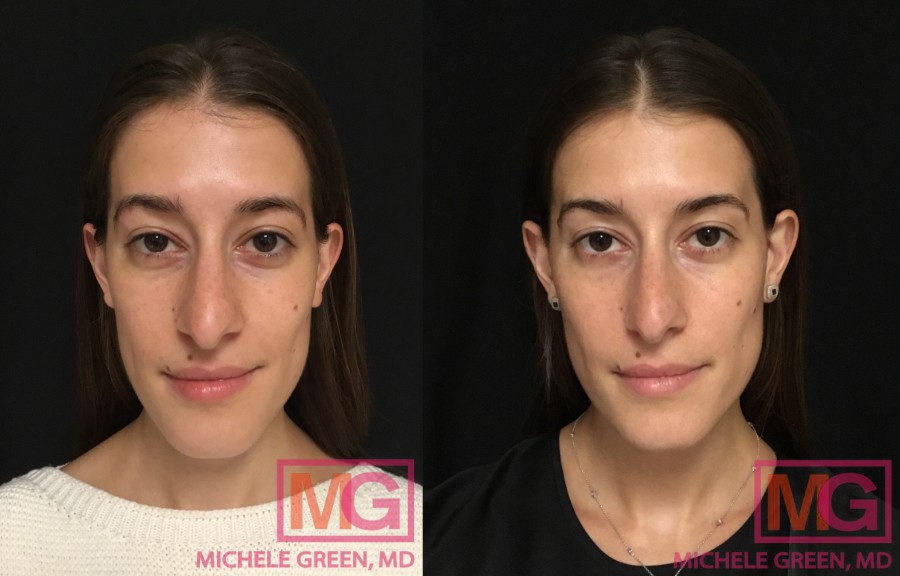Best Filler for Under Eyes
As we age, the production of collagen and elastin proteins decreases, leading to volume loss, higher skin laxity, and the appearance of fine lines and wrinkles. While these effects of the natural aging process can be apparent in many areas of the face, the under-eye area can be particularly affected. Volume loss, uneven skin texture, and pigmentation can contribute to the appearance of dark circles, under-eye bags, and tear-trough hollows that make patients always appear tired or worn. When looking to restore lost volume in the under-eye area for a more naturally youthful look, patients can turn to injectable fillers, which are easier to access than cosmetic surgery, providing stunning results with no downtime necessary. Since the under-eye region is a delicate area, it is essential to seek out dermal filler treatment from an experienced board-certified dermatologist, such as Dr. Michele Green, for safe and effective tear trough rejuvenation.
To treat the delicate area under the eyes, Dr. Green will turn to hyaluronic acid-based fillers from the Restylane, Juvederm, or Belotero families of fillers. These types of filler contain the active ingredient hyaluronic acid, which is a naturally occurring substance found in the body that helps with moisture retention in the skin. When injected into the under-eye area, hyaluronic acid-based dermal fillers can restore lost volume, eliminate hollows, and erase fine lines and wrinkles with natural-looking results. While dermal fillers like Restylane and Juvederm are not permanent, the results are long-lasting and can be repeated once every six months to a year to maintain the effects of the treatment. Unlike more invasive treatments like eyelid surgery, dermal fillers for the under-eye area are non-invasive and require no downtime following the treatment. Whether it is your first time seeking dermal filler treatment or a treatment you access regularly, it is always best to schedule your appointment with an expert injector, such as Dr. Michele Green.
Expert, board-certified dermatologist Dr. Michele Green has treated patients in her Upper East Side New York City office for over 25 years. Experienced in a myriad of cosmetic and medical skincare treatments, such as chemical peels, Botox, Microneedling, serums, and more, Dr. Green provides patients with many dermal filler treatment options, including the Restylane and Juvederm families of filler, Radiesse, Sculptra, and Belotero. When it comes to injecting any kind of dermal filler, Dr. Green opts for a less-is-more approach, creating a smooth, bright, naturally youthful appearance for patients. Well-known for high patient satisfaction, Dr. Green has been frequently voted one of the best dermatologists in New York City by such publications as Castle Connolly, Super Doctors, and New York Magazine.

What are tear-trough fillers for under-eye bags?
As collagen production decreases with age, the skin loses structure and elasticity, causing hollows to form in many areas of the face, including under the eyes, in the midface, and along the jawline. These infraorbital hollows can contribute to the appearance of dark circles under the eyes, as volume loss creates dark shadows. Patients experiencing dark circles or under-eye bags due to volume loss, hollows, or fine lines and wrinkles can turn to dermal fillers to rejuvenate the under-eye area for a naturally youthful look. Dermal fillers help to restore lost volume, eliminate shadows under the eyes, and even out skin texture for full facial rejuvenation.
How do dermal fillers work for under-eye hollows and dark circles?
Dermal fillers are a safe and effective treatment option for eliminating dark circles caused by volume loss and under-eye hollows. Your treatment process will begin with a consultation with expert board-certified dermatologist Dr. Michele Green, who will examine the treatment area to determine the most effective treatment option for you. If under-eye bags are caused by volume loss or tear-trough hollows, Dr. Green often recommends dermal fillers, such as Restylane, Juvederm, or Belotero. Using a small needle or cannula, Dr. Green will precisely place the dermal filler under the skin. Most patients do not experience any discomfort associated with the treatment, as dermal fillers contain a numbing solution called lidocaine, which helps to reduce the risk of pain during the injections. When injected into the under-eye area, the hyaluronic acid filler immediately replaces lost volume, fills in hollows, erases fine lines and wrinkles, and hydrates the skin. While the treatment is very long-lasting, the body eventually breaks down the hyaluronic acid gel, causing its effects to fade. However, the procedure can be repeated approximately once a year to maintain the results.
What are hyaluronic acid fillers?
Hyaluronic acid fillers are a type of dermal filler containing the active ingredient hyaluronic acid. Naturally found in the body, hyaluronic acid keeps the skin plump and hydrated and serves a similar purpose as the active ingredient in dermal fillers. When hyaluronic acid-based fillers are injected into the treatment area, they immediately serve to restore lost volume, reduce the appearance of fine lines and wrinkles, and plump the skin for a naturally youthful appearance. The most common hyaluronic acid-based fillers used are the Restylane and Juvederm families of dermal fillers. One particular advantage of hyaluronic acid fillers is that they can be dissolved using an enzyme called hyaluronidase if the results of the treatment are not satisfactory.
What is the best filler for under your eyes?
Patients often ask, “What is the best filler for the tear trough?” When filling in under-eye hollows, Dr. Green will most often turn to Restylane Eyelight or Juvederm Volbella. Both treatment options are hyaluronic acid-based and are highly effective at reducing signs of under-eye bags caused by volume loss. They differ in the type of cross-linking technology used to support the injectable solution. Restylane Eyelight works with NASHA cross-linking technology to keep the injectable gel in place, while Juvederm Volbella uses VyCross technology. Both Juvederm Volbella and Restylane Eyelight are specifically FDA-approved for use in the delicate under-eye area due to their smooth, thin formulation. Dr. Green recommends avoiding other types of dermal fillers, such as Radiesse and Sculptra, which are thicker solutions, meaning they are more likely to come with side effects like lumps and bumps.
Is Juvederm or Restylane better for under eyes?
Restylane and Juvederm are two different families of hyaluronic acid-based dermal fillers (HA fillers) that can be used to restore lost volume for a naturally youthful appearance. Both families of dermal filler injections are available at Dr. Green’s Upper East Side New York City dermatology office, and neither is inherently better than the other. When you have your initial consultation with Dr. Green, she will help you to determine which option is the best for you.
Restylane and Juvederm each have several different members of their dermal filler portfolio that are used to address signs of aging and provide the ideal facial contour across various areas of the face:
- To address wrinkles and creases, such as the nasolabial folds, smile lines, and marionette lines, Dr. Green will turn to Juvederm Ultra XC, Juvederm Ultra Plus XC, Juvederm Vollure, Restylane L, or Restylane Defyne.
- The choice of which member of the Restylane or Juvederm portfolio to use for lip augmentation will depend on the patient’s unique aesthetic goals. The best fillers for lips include Restylane Kysse, Restylane Silk, Juvederm Volbella, or Juvederm Ultra Plus.
- Dr. Green most often uses Juvederm Voluma, Restylane Contour, or Restylane Lyft to restore lost volume in the midface.
- For smaller lines around the mouth, Juvederm Volbella or Restylane Kysse are the best options.
- For chin augmentation and jawline contouring, Dr. Green will turn to Juvederm Volux or Restylane Defyne.
Whether you choose the Restylane or the Juvederm family of dermal fillers, Dr. Green will use her less-is-more approach to help you achieve the perfect facial contour.

Which under-eye filler lasts the longest?
Dermal fillers are a long-lasting treatment option for restoring lost volume under the eyes, but they are not permanent. Over time, the body will break down hyaluronic acid fillers like Juvederm Volbella and Restylane Eyelight, meaning that the treatment will need to be repeated every six months to a year to maintain the results. Restylane Eyelight has been shown to last for up to 18 months, while Juvederm Volbella lasts for up to a year. The exact longevity of the treatment effects depends on the number of syringes used and the patient’s metabolism.
What are the side effects of tear-trough dermal fillers?
Typically, side effects of dermal filler treatments are mild and will resolve quickly within 5-7 days of treatment. These common mild side effects include redness, swelling, bruising, itching, and tenderness at the injection site. Some patients may experience lumps under the skin following dermal filler treatment. If this is the case, hyaluronic acid filler can be dissolved using hyaluronidase. Patients must seek treatment from an expert dermatologist, such as Dr. Michele Green—especially when treating a delicate area like the under-eye. Receiving treatment from an inexperienced injector can result in improper placement or over-filling, which can contribute to more serious side effects, such as lymphatic obstruction, inflammation, filler migration, and nodules.
How much downtime for under-eye filler?
Hyaluronic acid-based dermal filler treatment does not involve downtime, so patients can immediately return to their regularly scheduled activities. However, some common side effects, such as redness, swelling, bruising, itching, irritation, or tenderness at the injection site, may occur. These side effects will go away within seven days of receiving the treatment. Dr. Green recommends that patients avoid taking blood thinners, such as Advil, before the treatment, as blood thinners can worsen potential bruising.
Who is a good candidate for under-eye filler?
The best candidate for dermal filler injections in the tear trough is a healthy individual with noted volume loss in the under-eye area. If there is excessive wrinkling or skin under the eyes with fat deposition, tear trough fillers may not be the best course of treatment. During your consultation with Dr. Green, she will physically evaluate your under-eye area to determine if tear trough fillers are the correct treatment for you or if another cosmetic procedure is better suited for you. Suppose you are not a suitable candidate for tear trough fillers or other non-invasive cosmetic treatment options. In that case, Dr. Green will refer you to a trusted board-certified plastic surgeon for a surgical consultation.

How to fix under-eye hollows without fillers
Dr. Green has many treatment options for under-eye hollows in her Upper East Side New York City dermatology office. Depending on your facial anatomy, Dr. Green will develop a treatment plan with the treatment or combination of treatments that will be most effective for you. In addition to dermal fillers, some other treatment options for the under-eye area include,
Thermage: Thermage treatment is best used for patients with increased skin laxity, which contributes to a hollow appearance under the eye. Thermage uses radiofrequency energy to heat the layers of skin, resulting in tighter, smoother skin.
Fraxel Laser: Dr. Green will use the Fraxel laser to resurface the skin under the eyes and boost collagen production. The eMatrix laser, in particular, has a tip designed specifically for this delicate area. Fraxel lasers tighten the skin to reduce the appearance of hollows and dark circles under the eyes.
Eye Cream: When looking for an eye cream that works wonders under the eyes, Dr. Green’s proprietary MGSKINLABs has the Intensive Eye Repair Cream. MGSKINLAB’s Intensive Eye Repair cream is a gel that works to reduce the look of puffiness, creases, and circles under the eye for a healthier, more youthful appearance.
Microneedling: Microneedling can treat a range of skin concerns, including uneven skin texture, pigmentation, fine lines, wrinkles, acne scars, and under-eye hollows. The treatment uses tiny surgical-grade needles to pierce the skin’s surface and create micro-wounds that boost the body’s natural healing process and increase collagen production for smoother, clearer skin.
Blepharoplasty: Some patients may benefit from a surgical procedure known as blepharoplasty, in which excess skin and fat are removed from the lower eyelid by a plastic surgeon. Blepharoplasty provides permanent results but requires a much longer recovery time than any non-surgical procedure.
What is Microneedling with PRP for dark circles?
Under-eye dark circles and wrinkles can be improved through Microneedling, which is a treatment option in which tiny surgical-grade needles pierce the skin to create microscopic wounds. The skin’s natural wound-healing process repairs these micro-injuries as new, healthier skin cells grow and new collagen and elastin are produced. This helps plump and firm skin, diminish signs of aging, and minimize the overall appearance of dark circles.
The effects of Microneedling can be further enhanced by combining the treatment with platelet-rich plasma (PRP). PRP employs the cytokines and growth factors in plasma derived from a sample of the patient’s blood to boost the effects of microneedling. The solution penetrates the skin more readily through the newly created micro-channels made by microneedles, helping to speed up the healing process and promote even more regeneration at the cellular level to rejuvenate your skin.
Is Botox better than fillers for under-eye bags?
Botox is best used to treat dynamic wrinkles that appear as a result of repeated use of facial muscles over time. If dynamic wrinkles cause fine lines and creases that appear under the eyes, Botox is the ideal treatment. Often, however, the appearance of wrinkles or hollows under the eye can be caused by a loss of volume in the face, which occurs due to the natural aging process. If this is the case, Dr. Green recommends hyaluronic acid fillers, such as Juvederm or Restylane. Other patients may benefit from skin tightening in the form of laser treatment or skin resurfacing with a Fraxel laser or chemical peel in order to boost collagen production for tighter, firmer skin.
The most noticeable dynamic wrinkles around the eyes are the crow’s feet, which are creases that appear at the corner of the eyes, extending outward in a fan shape when you smile or squint. The development of crow’s feet can be one of the earliest signs of the natural aging process. Luckily, crow’s feet can be easily treated with Botox, erasing signs of fine lines and wrinkles at the corner of the eye for up to six months. When Botox is injected into the facial muscles at the corners of the eye, the active ingredient, botulinum toxin type A, causes the muscles to freeze and relax, preventing muscle contractions in the area. As a result, crow’s feet disappear for a smoother, more youthful appearance.

What is better than under-eye filler?
Under-eye filler is a safe and effective treatment option for addressing volume loss in the under-eye area. There is no one best treatment option; rather, it is important to determine which treatment or combination of treatments will provide you with the best results. When you have your initial consultation with Dr. Green, she will examine the treatment area, and you will discuss your aesthetic goals. Afterward, she will create the treatment plan to meet your needs best.
Who should not get under-eye fillers?
Tear trough filler is a safe and effective treatment for under-eye hollows and dark shadows caused by volume loss. However, under-eye filler may not be for every patient. In particular, if dark circles are caused by pigmentation from sun damage or blood vessels close to the skin’s surface, dermal fillers will not be the most effective treatment option. The under-eye area is very delicate, so it is important to only turn to dermal fillers for patients who have experienced significant age-related volume loss or who have a naturally hooded appearance. The best first step for under-eye bag treatment is to consult with expert dermatologist Dr. Michele Green.
What fillers are best for under eyes?
Dr. Green often uses hyaluronic acid fillers, such as Juvederm Volbella, Restylane, Restylane Eyelight, and Belotero Balance. Hyaluronic acid (HA) is a substance that occurs naturally in the body. HA fillers restore lost volume and hydration in the tear troughs to correct tired-looking eyes and under-eye bags. These specific fillers have a soft formulation that enhances your natural appearance for a rejuvenated look.
Juvederm Volbella is the first FDA-approved dermal filler for treating tear troughs. Its thin formulation is the thinnest in the Juvederm family. The dermal filler’s patented VyCross technology allows for smooth and even distribution under the skin.
Restylane Eyelight dermal filler is commonly used to improve the look of hollowing and under-eye bags. Restylane can help restore lost volume in the tear trough area and reduce the appearance of fine lines and wrinkles in the treatment area. Restylane Eyelight is a newer dermal filler that was FDA-approved in 2023 for use under the eyes. This dermal filler uses crosslinking and patented NASHA technology to erase under-eye hollowing and dark circles caused by lost volume.
Belotero Balance provides a soft and even correction in the skin, making it a highly effective filler option for tear troughs. Belotero has an ultra-thin and flexible formulation that can eliminate developing a side effect known as the Tyndall effect. The Tyndall effect can create a bluish hue in the injected area due to the reflection of light off of particles suspended in the filler. Belotero eliminates the risk of developing the Tyndall effect, as there are no suspended particles in Belotero.
The best filler for tear troughs will depend on your facial anatomy, skin concerns, and cosmetic goals. When you consult with Dr. Green, she will assess you in person to determine which dermal filler is most appropriate for you.
What fillers make your eyes look younger?
When looking to achieve a naturally youthful appearance, Dr. Green will turn to hyaluronic acid-based fillers, such as Juvederm Volbella and Restylane Eyelight. These fillers have a thinner formulation than many of the other hyaluronic acid dermal fillers, making them ideal for the delicate area under the eye. Both Juvederm Volbella and Restylane Eyelight are FDA-approved for the treatment of under-eye hollows, providing patients with natural-looking results.
What is the newest filler for under eyes?
Juvederm Volbella was the first dermal filler that was FDA-approved specifically to treat the under-eye area. Previously, other types of dermal fillers like Restylane L were used as an “off-label” treatment for the under-eye area, meaning that the filler was not FDA-approved for use in that area. The newest filler for under the eyes is Restylane Eyelight, which was FDA-approved in 2023. As Dr. Green is always on the cutting edge of new treatments, she was one of the first dermatologists to offer the treatment in her New York City office.

How much do under-eye fillers cost?
Patients often wonder, “How much does permanent under-eye filler cost?” The total price of under-eye filler injections depends on a variety of factors, including your geographic location, the type of institution at which you receive treatment, and whether you pair dermal fillers with other non-surgical treatments like microneedling, chemical peels, or Botox. While receiving treatment at a Medical Spa may be cheaper due to specials, the risk of developing serious side effects increases when you seek treatment from a less experienced provider. Without the proper injector training, it is possible to inject the dermal filler into a blood vessel, which can cause serious damage, and the risk of serious side effects like the Tyndall effect, puffiness, plumping, and nodules under the eyes is higher. That is why it is always best to seek out an expert injector, such as board-certified dermatologist Dr. Michele Green.
How to get started with under-eye fillers today
Tear trough fillers are a non-invasive cosmetic procedure designed for the rejuvenation of the under-eye area. A tear trough is a crease in the under-eye area that looks sunken in, causing a tired, worn-out appearance and often worsening over time with age. Tear trough filler injections are placed between the lower eyelid and upper cheek to replenish volume and smooth out the under-eye hollows that can cast a shadow and result in the appearance of dark circles. If you’re looking for a solution for tired-looking under-eyes that doesn’t involve plastic surgery, significant downtime, or side effects, Dr. Green in NYC is here to help.
Dr. Michele Green is an internationally renowned board-certified dermatologist with over two and a half decades of experience providing her patients with the best non-invasive treatment options. Dr. Green takes a holistic approach and embraces a less-is-more philosophy, creating customized skincare routines and treatment plans that cater to the unique concerns and aesthetic goals of her patients. She is consistently identified as one of New York’s best dermatologists by Castle Connolly, New York Magazine, and Super Doctors for her dedication to her patients and expertise. Please call us at 212-535-3088 or email our New York City-based office today to schedule a consultation with Dr. Michele Green and determine which under-eye filler treatment option is best for you.
 212-535-3088
212-535-3088